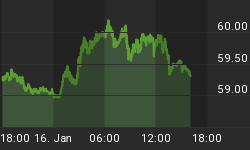The good news is:
· There were 136 NASDAQ new highs Friday, the highest number wehave seen since December 30 and NYSE new highs at 405 were the highest we haveseen since December 1.
· All of the broad market Summation indices have turned upward.
New high indicators (10% trend - 19 day EMA of new highs) are pretty good indicators of market trend, i.e. if the indicator continues to move upward on a down day for the averages or if the indicator continues to move downward on an up day for the averages, the direction of the indicator is likely to prevail.
The chart below shows the NYSE new high indicator in blue and the NASDAQ new high indicator in green along with the S&P 500 (SPX) in red. There have been two down days since the low of January 24, on each one of the down days there were enough new highs to keep the indicators moving upward.

A Summation Index (SI) is a running total of oscillator values. If the oscillator is positive the SI moves upward and if the oscillator is negative the SI moves downward.
The chart below shows the NASDAQ composite (OTC) in red and SI's calculated from NASDAQ advancing issues - declining issues (AD), new highs - new lows (HL) and upside - downside volume (UD). When all of the SI's are heading in the same direction, it is imprudent to bet against them. The AD and HL SI's are moving upward while the UD SI is flat.

The chart below shows the UD oscillator that is the input for the UD SI. For the past week it has been hovering around the 0 line. Since the August low the UD SI has been the best of the SI's for indicating market trend, it would be comforting to see its direction resolved to the upside.

The chart below shows the SI's calculated from the component issues of the SPX. New highs and new lows were calculated on the trailing 6 weeks rather than the trailing 52 weeks as reported by the exchanges. Using only the large cap issues represented in the SPX all the SI's have turned upward.

The chart below shows the Russell 2000 (R2K) in red, the SPX in green and a FastTrack relative strength indicator called Accutrack as a histogram in yellow. In mid August Accutrack began rising indicating the small caps were leading the move up. The indicator stayed positive until early January and began moving upward again in early-mid January. The indicator returned to positive territory last week.

Seasonally next week has a negative bias.
In the 1st year of the presidential cycle the 5th and 8th trading days which will be Monday and Thursday are the only two days that have been on average up. The 7th trading day which will be Wednesday has, since 1965, never been up.
February trading days 5 - 9
Using OTC
The number following the year represents its position in the presidential cycle.
The number following the daily return represents the day of the week;
1 = Monday, 2 = Tuesday etc.
| Presidential Year 1 | |||||
| Day 5 | Day 6 | Day 7 | Day 8 | Day 9 | |
| 1965-1 | 0.15% 5 | -0.33% 1 | -0.25% 2 | 0.53% 3 | -1.38% 4 |
| 1969-1 | 0.21% 5 | 0.25% 2 | -0.23% 3 | 0.32% 4 | 0.00% 5 |
| 1973-1 | 0.21% 3 | -1.01% 4 | -0.82% 5 | 1.52% 1 | 1.06% 2 |
| 1977-1 | -0.13% 1 | -0.02% 2 | -0.62% 3 | 0.31% 4 | -0.21% 5 |
| 1981-1 | 0.80% 5 | -0.48% 1 | -0.12% 2 | -0.45% 3 | -0.61% 4 |
| 1985-1 | 0.96% 4 | 0.40% 5 | -0.32% 1 | -0.30% 2 | 0.61% 3 |
| Avg | 0.41% | -0.17% | -0.42% | 0.28% | 0.17% |
| 1989-1 | 0.79% 2 | -0.30% 3 | -0.39% 4 | -0.99% 5 | -0.27% 1 |
| 1993-1 | -1.11% 5 | -0.36% 1 | -0.89% 2 | 0.41% 3 | 0.12% 4 |
| 1997-1 | 0.84% 5 | -1.65% 1 | -0.29% 2 | 2.07% 3 | 0.86% 4 |
| 2001-1 | -2.13% 3 | -1.75% 4 | -3.56% 5 | 0.76% 1 | -2.49% 2 |
| Avg | -0.32% | -0.81% | -1.03% | 0.45% | -0.36% |
| Averages | 0.05% | -0.48% | -0.68% | 0.38% | -0.21% |
| % Winners | 64% | 18% | 00% | 64% | 36% |
The strong move Monday turned most of the important indicators upward. So far this rally has coincided almost perfectly with the seasonally strong end of January / beginning of February period which ends Monday. Although the period of seasonal strength ends Monday, the momentum of this rally should carry the market at least a little higher.
I expect the major indices to be higher on Friday February 11 than they were on Friday February 4.
Last weeks negative forecast based on skepticism of the rally as of last Friday was an obvious bust by Monday's close. I hate it when that happens.
Gordon Harms produces a power point for our local FastTrack users group. You can download it at http://www.guaranteed-profits.com
















